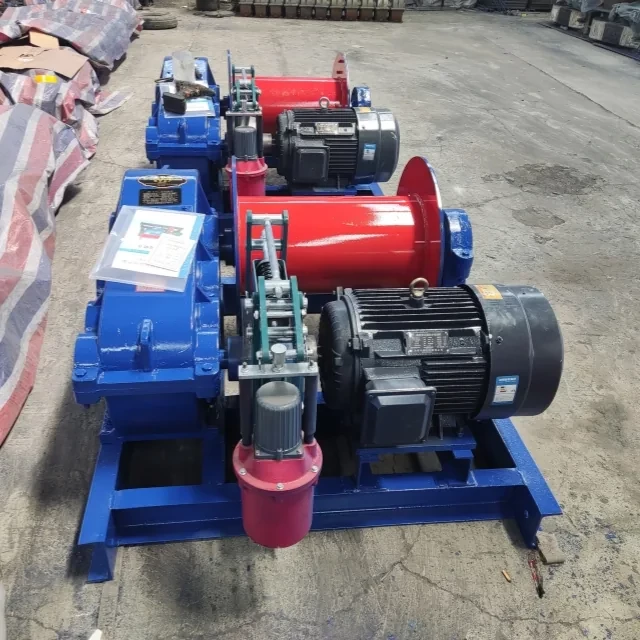Introduction
High-speed winches have become indispensable tools across heavy industries, transforming how professionals handle demanding lifting and pulling tasks. Unlike standard winches, these specialized systems combine rapid operation with precision control to address unique operational challenges—from constructing skyscrapers to maintaining railway networks. This article breaks down their industry-specific applications and technical advantages, helping you evaluate their role in improving safety, efficiency, and cost-effectiveness in your operations.
High-Speed Winches in Industrial Operations
1. Construction: Vertical Lifting for High-Rise Material Transport
In urban construction, time-sensitive material delivery to upper floors is a constant challenge. High-speed winches enable:
- Faster cycle times: Move steel beams, concrete panels, and modular components at 2–3x the speed of traditional hoists.
- Precision placement: Integrated braking systems allow millimeter-accurate positioning, even in windy conditions.
- Space optimization: Compact designs fit congested job sites while handling loads up to 20 tons.
Ever wondered how skyscraper projects meet tight deadlines? High-speed winches act as the "elevators" for materials, keeping workflows uninterrupted.
2. Rail Maintenance: Horizontal Dragging of Track Components
Railway crews rely on winches to replace worn-out tracks or reposition heavy switches. Key benefits include:
- Directional flexibility: Motorized drums can pull horizontally for hundreds of meters without losing torque.
- Minimized downtime: Rapid cable retraction speeds (e.g., 30 m/min) accelerate track renewal projects.
- Adaptability: Modular designs attach to rail-mounted vehicles for mobile operations.
3. Mining: Slope Pulling Under Hazardous Conditions
Mining environments demand equipment that performs under extreme stress. High-speed winches excel here by offering:
- Explosion-proof models: Certified for use in methane-rich underground tunnels.
- Grade climbing: Motorized systems haul ore carts up 45-degree inclines without slippage.
- Remote operation: Wireless controls keep workers at a safe distance during high-risk pulls.
Technical Features Driving Efficiency
1. Dynamic Load Capacity for Heavy Objects
These winches aren’t just fast—they’re engineered to manage variable loads intelligently:
- Automatic tension adjustment: Sensors detect load shifts (e.g., swinging cargo) and compensate in real time.
- Shock resistance: Reinforced gearboxes withstand sudden force changes, common in mining or marine recovery.
Think of these systems as the "shock absorbers" of heavy lifting—smoothing out irregularities that could damage equipment or materials.
2. Safety Mechanisms in Rugged Environments
Fail-safes are critical when handling multi-ton loads:
- Dual braking: Mechanical + electromagnetic brakes engage if power fails.
- Overload cutoffs: Automatically halt operations when exceeding 110% rated capacity.
- Corrosion-resistant builds: Stainless steel or coated components endure saltwater, dust, and chemicals.
3. Energy Efficiency in Continuous Operations
Modern designs reduce operational costs through:
- Regenerative braking: Recaptures energy during descent or deceleration, cutting power use by ~15%.
- Variable-speed motors: Adjust power output to match load demands, avoiding wasteful "full throttle" operation.
Conclusion: Matching Winch Capabilities to Your Needs
High-speed winches like those from Garlway solve two universal industrial pain points: time-sensitive material handling and high-risk load management. When evaluating options, prioritize:
- Industry-specific requirements (e.g., explosion-proofing for mining).
- Total cost of ownership, factoring in energy savings and durability.
- Safety certifications relevant to your region or sector.
For operations requiring both speed and reliability, these systems aren’t just tools—they’re productivity multipliers. Explore how integrating them can streamline your most demanding tasks while keeping crews safe.
Related Products
- Electric and Hydraulic Winch for Heavy Duty Applications
- Ready Mixer Machine for Construction Ready Mix Machinery
- Heavy Duty Electric Boat Winch Windlass Anchor
- Best 18000 Pound Drum Anchor Trailer Winch
- 12000 lb Heavy Duty Electric Boat Winch
Related Articles
- How Ergonomic Engineering Transforms Electric Winch Usability for Modern Operators
- How Electric Winch Safety Features Prevent Catastrophic Industrial Accidents
- How to Choose and Safely Operate Winches for Construction Efficiency
- How to Maximize Electrical Winch Performance in Challenging Environments
- How Electric Winches Outperform Hydraulic Systems in Cost and Efficiency













